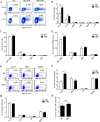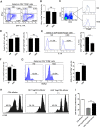High salt diet stimulates gut Th17 response and exacerbates TNBS-induced colitis in mice
- PMID: 27926535
- PMCID: PMC5352190
- DOI: 10.18632/oncotarget.13783
High salt diet stimulates gut Th17 response and exacerbates TNBS-induced colitis in mice
Abstract
This study focuses on characterizing the effect of a high salt diet (HSD) on intestinal immunity and the risk of inflammatory bowel diseases (IBD). We found that mice on a HSD had an increased frequency of IL-17A producing cells in the intestinal lamina propria (LP) compared to mice on a normal diet (ND). Furthermore, most intestinal IL-17A producing cells were CD4+TCRβ+ cells. A HSD increased the LP T helper 17 (Th17) responses in both the small and large intestines but did not increase the Th17 response of other gut-associated lymphoid organ. Although, HSD did not change the percentage of regulatory T (Treg) cells, HSD significantly inhibit secretion of IL-10 and the suppressive function of Treg cells. Moreover, we found that HSD exacerbates trinitrobenzenesulfonic acid (TNBS) induced colitis, and Th17 response was significantly increased in the colonic LP of HSD TNBS-treated mice compared with the ND TNBS-treated mice. This study demonstrates that HSD stimulates the intestinal Th17 response but inhibits the function of Treg cells. Moreover, HSD exacerbates TNBS induced mice colitis, suggesting that HSD disrupts the intestinal immunity and increases the risk of IBD.
Keywords: Immune response; Immunity; Immunology and Microbiology Section; Th17 cells; high salt diet; inflammatory bowel diseases; intestinal immunity; regulatory T cells.
Conflict of interest statement
The authors declare that there are no conflicts of interest.
Figures





References
-
- Landsberg L, Aronne LJ, Beilin LJ, Burke V, Igel LI, Lloyd-Jones D, Sowers J. Obesity-related hypertension: pathogenesis, cardiovascular risk, and treatment—a position paper of the The Obesity Society and The American Society of Hypertension. Obesity (Silver Spring, Md) 2013;21(1):8–24. - PubMed
-
- Appel LJ, Frohlich ED, Hall JE, Pearson TA, Sacco RL, Seals DR, Sacks FM, Smith SC, Jr, Vafiadis DK, Van Horn LV. The importance of population-wide sodium reduction as a means to prevent cardiovascular disease and stroke: a call to action from the American Heart Association. Circulation. 2011;123(10):1138–1143. - PubMed
-
- Brown IJ, Tzoulaki I, Candeias V, Elliott P. Salt intakes around the world: implications for public health. International journal of epidemiology. 2009;38(3):791–813. - PubMed
-
- Savica V, Bellinghieri G, Kopple JD. The effect of nutrition on blood pressure. Annual review of nutrition. 2010;30:365–401. - PubMed
MeSH terms
Substances
LinkOut - more resources
Full Text Sources
Other Literature Sources
Medical
Research Materials

